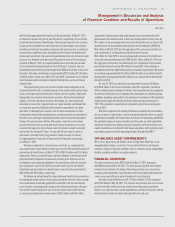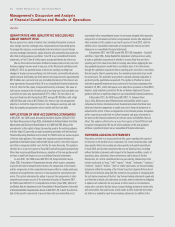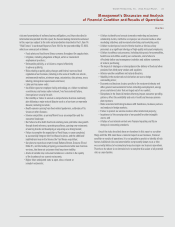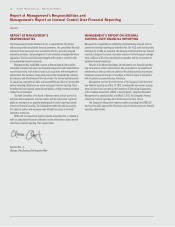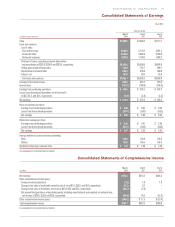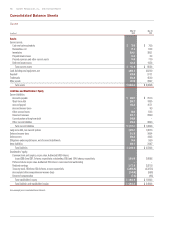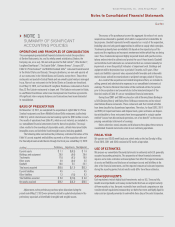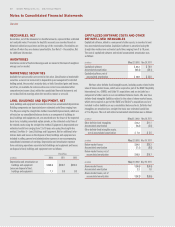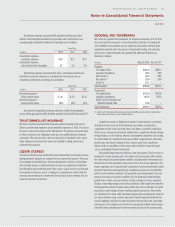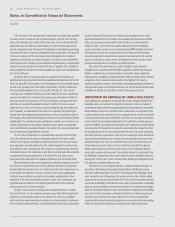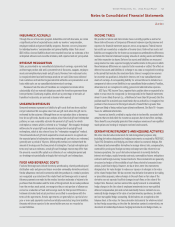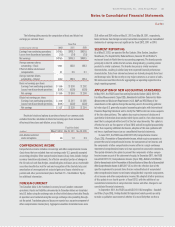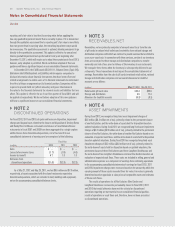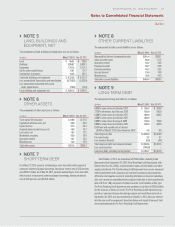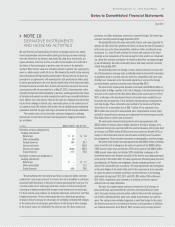Red Lobster 2012 Annual Report Download - page 43
Download and view the complete annual report
Please find page 43 of the 2012 Red Lobster annual report below. You can navigate through the pages in the report by either clicking on the pages listed below, or by using the keyword search tool below to find specific information within the annual report.
Notes to Consolidated Financial Statements
Darden
Darden Restaurants, Inc. 2012 Annual Report 39
`NOTE 1
SUMMARY OF SIGNIFICANT
ACCOUNTING POLICIES
OPERATIONS AND PRINCIPLES OF CONSOLIDATION
The accompanying consolidated financial statements include the operations
of Darden Restaurants, Inc. and its wholly owned subsidiaries (Darden, the
Company, we, us or our). We own and operate the Red Lobster®, Olive Garden®,
LongHorn Steakhouse®, The Capital Grille®, Bahama Breeze®, Seasons 52®,
Eddie V’s Prime Seafood® and Wildfish Seafood Grille® restaurant brands located
in the United States and Canada. Through subsidiaries, we own and operate all
of our restaurants in the United States and Canada, except three. Those three
restaurants are located in Central Florida and are owned by joint ventures managed
by us. None of our restaurants in the United States or Canada are franchised.
As of May 27, 2012, we franchised 5 LongHorn Steakhouse restaurants in Puerto
Rico, 22 Red Lobster restaurants in Japan, and 1 Red Lobster restaurant in Dubai,
to unaffiliated franchisees under area development and franchise agreements.
All significant inter-company balances and transactions have been eliminated
in consolidation.
BASIS OF PRESENTATION
On November 14, 2011, we completed the acquisition of eight Eddie V’s Prime
Seafood restaurants and three Wildfish Seafood Grille restaurants (collectively
Eddie V’s) and all related assets and net working capital for $58.5 million in cash.
The results of operations from Eddie V’s, which are not material, are included in
our consolidated financial statements from the date of acquisition. The acqui-
sition resulted in the recording of depreciable assets, definite-lived amortizable
intangible assets and indefinite-lived intangible assets, including goodwill.
The following table summarizes the preliminary estimated fair values of the
Eddie V’s assets acquired and liabilities assumed as of the acquisition date and
the final adjustments made thereto through the fiscal year ended May 27, 2012:
(in millions)
Preliminary Adjustments Final Adjusted
Current assets $ 1.7 $(0.3) $ 1.4
Buildings and equipment 26.8 (0.4) 26.4
Trademarks 17.0 (6.1) 10.9
Other assets 2.9 (0.4) 2.5
Goodwill 16.6 5.5 22.1
Total assets acquired $65.0 $(1.7) $63.3
Current liabilities 4.5 — 4.5
Other liabilities 1.3 (1.0) 0.3
Total liabilities assumed $ 5.8 $(1.0) $ 4.8
Net assets acquired $59.2 $(0.7) $58.5
Adjustments to the preliminary purchase price allocation during the
period ended May 27, 2012 were primarily related to updated valuations in the
preliminary appraisals of identifiable intangible and tangible assets.
The excess of the purchase price over the aggregate fair value of net assets
acquired was allocated to goodwill, all of which is expected to be deductible for
tax purposes. Goodwill represents benefits expected as a result of the acquisition,
including sales and unit growth opportunities in addition to supply-chain synergies.
Trademarks primarily have an indefinite life based on the expected use of the
assets and the regulatory and economic environment within which they are being
used. These trademarks represent highly respected brands with positive conno-
tations and we intend to cultivate and protect the use of these brands. Goodwill
and indefinite-lived trademarks are not amortized but are reviewed annually for
impairment or more frequently if indicators of impairment exist. Buildings and
equipment will be depreciated over a period of 5 months to 23 years. Other
assets and liabilities represent value associated with favorable and unfavorable
market leases and will be amortized over a weighted-average period of 16 years.
As a result of the acquisition and related integration efforts, are included in
selling, general and administrative expenses in our consolidated statements of
earnings. Pro-forma financial information of the combined entities for periods
prior to the acquisition is not presented due to the immaterial impact of the
financial results of Eddie V’s on our consolidated financial statements.
During fiscal 2007 and 2008 we closed or sold all Smokey Bones Barbeque
& Grill (Smokey Bones) and Rocky River Grillhouse restaurants and we closed
nine Bahama Breeze restaurants. These restaurants and their related activities
have been classified as discontinued operations. Therefore, for fiscal 2012, 2011
and 2010, all impairment losses and disposal costs, gains and losses on disposi-
tion attributable to these restaurants have been aggregated in a single caption
entitled “Losses from discontinued operations, net of tax benefit” on the accom-
panying consolidated statements of earnings.
Unless otherwise noted, amounts and disclosures throughout these notes to
consolidated financial statements relate to our continuing operations.
FISCAL YEAR
We operate on a 52/53 week fiscal year, which ends on the last Sunday in May.
Fiscal 2012, 2011 and 2010 consisted of 52 weeks of operation.
USE OF ESTIMATES
We prepare our consolidated financial statements in conformity with U.S. generally
accepted accounting principles. The preparation of these financial statements
requires us to make estimates and assumptions that affect the reported amounts
of assets and liabilities and disclosure of contingent assets and liabilities at the
date of the financial statements, and the reported amounts of sales and expenses
during the reporting period. Actual results could differ from those estimates.
CASH EQUIVALENTS
Cash equivalents include highly liquid investments such as U.S. Treasury bills,
taxable municipal bonds and money market funds that have an original maturity
of three months or less. Amounts receivable from credit card companies are also
considered cash equivalents because they are both short term and highly liquid in
nature and are typically converted to cash within three days of the sales transaction.


